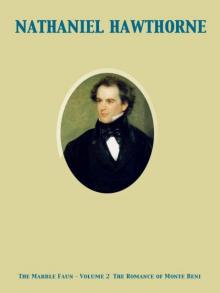- Home
- Nathaniel Hawthorne
The Marble Faun; Or, The Romance of Monte Beni - Volume 1 Page 3
The Marble Faun; Or, The Romance of Monte Beni - Volume 1 Read online
Page 3
CHAPTER III
SUBTERRANEAN REMINISCENCES
Miriam's model has so important a connection with our story, that it isessential to describe the singular mode of his first appearance, andhow he subsequently became a self-appointed follower of the young femaleartist. In the first place, however, we must devote a page or two tocertain peculiarities in the position of Miriam herself.
There was an ambiguity about this young lady, which, though it did notnecessarily imply anything wrong, would have operated unfavorably asregarded her reception in society, anywhere but in Rome. The truth was,that nobody knew anything about Miriam, either for good or evil. She hadmade her appearance without introduction, had taken a studio, put hercard upon the door, and showed very considerable talent as a painter inoils. Her fellow professors of the brush, it is true, showered abundantcriticisms upon her pictures, allowing them to be well enough for theidle half-efforts of an amateur, but lacking both the trained skill andthe practice that distinguish the works of a true artist.
Nevertheless, be their faults what they might, Miriam's pictures metwith good acceptance among the patrons of modern art. Whatever technicalmerit they lacked, its absence was more than supplied by a warmthand passionateness, which she had the faculty of putting into herproductions, and which all the world could feel. Her nature had a greatdeal of color, and, in accordance with it, so likewise had her pictures.
Miriam had great apparent freedom of intercourse; her manners were sofar from evincing shyness, that it seemed easy to become acquainted withher, and not difficult to develop a casual acquaintance into intimacy.Such, at least, was the impression which she made, upon brief contact,but not such the ultimate conclusion of those who really sought to knowher. So airy, free, and affable was Miriam's deportment towards all whocame within her sphere, that possibly they might never be conscious ofthe fact, but so it was, that they did not get on, and were seldom anyfurther advanced into her good graces to-day than yesterday. By somesubtile quality, she kept people at a distance, without so much asletting them know that they were excluded from her inner circle. Sheresembled one of those images of light, which conjurers evoke and causeto shine before us, in apparent tangibility, only an arm's length beyondour grasp: we make a step in advance, expecting to seize the illusion,but find it still precisely so far out of our reach. Finally, societybegan to recognize the impossibility of getting nearer to Miriam, andgruffly acquiesced.
There were two persons, however, whom she appeared to acknowledge asfriends in the closer and truer sense of the word; and both of thesemore favored individuals did credit to Miriam's selection. One wasa young American sculptor, of high promise and rapidly increasingcelebrity; the other, a girl of the same country, a painter like Miriamherself, but in a widely different sphere of art. Her heart flowed outtowards these two; she requited herself by their society and friendship(and especially by Hilda's) for all the loneliness with which, asregarded the rest of the world, she chose to be surrounded. Her twofriends were conscious of the strong, yearning grasp which Miriam laidupon them, and gave her their affection in full measure; Hilda, indeed,responding with the fervency of a girl's first friendship, and Kenyonwith a manly regard, in which there was nothing akin to what isdistinctively called love.
A sort of intimacy subsequently grew up between these three friendsand a fourth individual; it was a young Italian, who, casually visitingRome, had been attracted by the beauty which Miriam possessed in aremarkable degree. He had sought her, followed her, and insisted, withsimple perseverance, upon being admitted at least to her acquaintance; aboon which had been granted, when a more artful character, seeking it bya more subtle mode of pursuit, would probably have failed to obtain it.This young man, though anything but intellectually brilliant, had manyagreeable characteristics which won him the kindly and half-contemptuousregard of Miriam and her two friends. It was he whom they calledDonatello, and whose wonderful resemblance to the Faun of Praxitelesforms the keynote of our narrative.
Such was the position in which we find Miriam some few months after herestablishment at Rome. It must be added, however, that the world did notpermit her to hide her antecedents without making her the subject ofa good deal of conjecture; as was natural enough, considering theabundance of her personal charms, and the degree of notice that sheattracted as an artist. There were many stories about Miriam's originand previous life, some of which had a very probable air, while otherswere evidently wild and romantic fables. We cite a few, leaving thereader to designate them either under the probable or the romantic head.
It was said, for example, that Miriam was the daughter and heiress ofa great Jewish banker (an idea perhaps suggested by a certain richOriental character in her face), and had fled from her paternal hometo escape a union with a cousin, the heir of another of that goldenbrotherhood; the object being to retain their vast accumulation ofwealth within the family. Another story hinted that she was a Germanprincess, whom, for reasons of state, it was proposed to give inmarriage either to a decrepit sovereign, or a prince still in hiscradle. According to a third statement, she was the off-spring of aSouthern American planter, who had given her an elaborate education andendowed her with his wealth; but the one burning drop of Africanblood in her veins so affected her with a sense of ignominy, that sherelinquished all and fled her country. By still another account she wasthe lady of an English nobleman; and, out of mere love and honor ofart, had thrown aside the splendor of her rank, and come to seek asubsistence by her pencil in a Roman studio.
In all the above cases, the fable seemed to be instigated by the largeand bounteous impression which Miriam invariably made, as if necessityand she could have nothing to do with one another. Whatever deprivationsshe underwent must needs be voluntary. But there were other surmises,taking such a commonplace view as that Miriam was the daughter of amerchant or financier, who had been ruined in a great commercial crisis;and, possessing a taste for art, she had attempted to support herself bythe pencil, in preference to the alternative of going out as governess.
Be these things how they might, Miriam, fair as she looked, was pluckedup out of a mystery, and had its roots still clinging to her. She was abeautiful and attractive woman, but based, as it were, upon a cloud, andall surrounded with misty substance; so that the result was to renderher sprite-like in her most ordinary manifestations. This was the caseeven in respect to Kenyon and Hilda, her especial friends. But such wasthe effect of Miriam's natural language, her generosity, kindliness, andnative truth of character, that these two received her as a dear friendinto their hearts, taking her good qualities as evident and genuine, andnever imagining that what was hidden must be therefore evil.
We now proceed with our narrative.
The same party of friends, whom we have seen at the sculpture-gallery ofthe Capitol, chanced to have gone together, some months before, to thecatacomb of St. Calixtus. They went joyously down into that vasttomb, and wandered by torchlight through a sort of dream, in whichreminiscences of church aisles and grimy cellars--and chiefly thelatter--seemed to be broken into fragments, and hopelessly intermingled.The intricate passages along which they followed their guide had beenhewn, in some forgotten age, out of a dark-red, crumbly stone. On eitherside were horizontal niches, where, if they held their torches closely,the shape of a human body was discernible in white ashes, into which theentire mortality of a man or woman had resolved itself. Among all thisextinct dust, there might perchance be a thigh-bone, which crumbled ata touch; or possibly a skull, grinning at its own wretched plight, as isthe ugly and empty habit of the thing.
Sometimes their gloomy pathway tended upward, so that, through acrevice, a little daylight glimmered down upon them, or even a streak ofsunshine peeped into a burial niche; then again, they went downward bygradual descent, or by abrupt, rudely hewn steps, into deeper and deeperrecesses of the earth. Here and there the narrow and tortuous passageswidened somewhat, developing themselves into small chapels;--whichonce, no doubt, had been adorned with marble-work and lig
hted withever-burning lamps and tapers. All such illumination and ornament,however, had long since been extinguished and stript away; except,indeed, that the low roofs of a few of these ancient sites of worshipwere covered with dingy stucco, and frescoed with scriptural scenes andsubjects, in the dreariest stage of ruin.
In one such chapel, the guide showed them a low arch, beneath which thebody of St. Cecilia had been buried after her martyrdom, and where itlay till a sculptor saw it, and rendered it forever beautiful in marble.
In a similar spot they found two sarcophagi, one containing a skeleton,and the other a shrivelled body, which still wore the garments of itsformer lifetime.
"How dismal all this is!" said Hilda, shuddering. "I do not know why wecame here, nor why we should stay a moment longer."
"I hate it all!" cried Donatello with peculiar energy. "Dear friends,let us hasten back into the blessed daylight!"
From the first, Donatello had shown little fancy for the expeditionfor, like most Italians, and in especial accordance with the law of hisown simple and physically happy nature, this young man had an infiniterepugnance to graves and skulls, and to all that ghastliness which theGothic mind loves to associate with the idea of death. He shuddered,and looked fearfully round, drawing nearer to Miriam, whose attractiveinfluence alone had enticed him into that gloomy region.
"What a child you are, poor Donatello!" she observed, with the freedomwhich she always used towards him. "You are afraid of ghosts!"
"Yes, signorina; terribly afraid!" said the truthful Donatello.
"I also believe in ghosts," answered Miriam, "and could tremble at them,in a suitable place. But these sepulchres are so old, and these skullsand white ashes so very dry, that methinks they have ceased to behaunted. The most awful idea connected with the catacombs is theirinterminable extent, and the possibility of going astray into thislabyrinth of darkness, which broods around the little glimmer of ourtapers."
"Has any one ever been lost here?" asked Kenyon of the guide.
"Surely, signor; one, no longer ago than my father's time," said theguide; and he added, with the air of a man who believed what he wastelling, "but the first that went astray here was a pagan of old Rome,who hid himself in order to spy out and betray the blessed saints, whothen dwelt and worshipped in these dismal places. You have heard thestory, signor? A miracle was wrought upon the accursed one; and, eversince (for fifteen centuries at least), he has been groping in thedarkness, seeking his way out of the catacomb."
"Has he ever been seen?" asked Hilda, who had great and tremulous faithin marvels of this kind.
"These eyes of mine never beheld him, signorina; the saints forbid!"answered the guide. "But it is well known that he watches near partiesthat come into the catacomb, especially if they be heretics, hoping tolead some straggler astray. What this lost wretch pines for, almost asmuch as for the blessed sunshine, is a companion to be miserable withhim."
"Such an intense desire for sympathy indicates something amiable in thepoor fellow, at all events," observed Kenyon.
They had now reached a larger chapel than those heretofore seen; itwas of a circular shape, and, though hewn out of the solid mass of redsandstone, had pillars, and a carved roof, and other tokens of a regulararchitectural design. Nevertheless, considered as a church, it wasexceedingly minute, being scarcely twice a man's stature in height, andonly two or three paces from wall to wall; and while their collectedtorches illuminated this one small, consecrated spot, the great darknessspread all round it, like that immenser mystery which envelops ourlittle life, and into which friends vanish from us, one by one. "Why,where is Miriam?" cried Hilda. The party gazed hurriedly from face toface, and became aware that one of their party had vanished intothe great darkness, even while they were shuddering at the remotepossibility of such a misfortune.

 The Scarlet Letter
The Scarlet Letter Young Goodman Brown : By Nathaniel Hawthorne - Illustrated
Young Goodman Brown : By Nathaniel Hawthorne - Illustrated The Birthmark
The Birthmark The Marble Faun; Or, The Romance of Monte Beni - Volume 1
The Marble Faun; Or, The Romance of Monte Beni - Volume 1 The Minister's Black Veil
The Minister's Black Veil The Great Stone Face, and Other Tales of the White Mountains
The Great Stone Face, and Other Tales of the White Mountains The House of the Seven Gables
The House of the Seven Gables The Snow Image
The Snow Image The Blithedale Romance
The Blithedale Romance Rappaccini's Daughter: By Nathaniel Hawthorne - Illustrated
Rappaccini's Daughter: By Nathaniel Hawthorne - Illustrated Twice-Told Tales
Twice-Told Tales Twice Told Tales
Twice Told Tales The Marble Faun; Or, The Romance of Monte Beni - Volume 2
The Marble Faun; Or, The Romance of Monte Beni - Volume 2_preview.jpg) Footprints on the Sea-Shore (From Twice Told Tales)
Footprints on the Sea-Shore (From Twice Told Tales) Main Street
Main Street_preview.jpg) The Seven Vagabonds (From Twice Told Tales)
The Seven Vagabonds (From Twice Told Tales) Fanshawe
Fanshawe Chippings with a Chisel
Chippings with a Chisel Selected Tales and Sketches
Selected Tales and Sketches Young Goodman Brown
Young Goodman Brown Roger Malvin's Burial
Roger Malvin's Burial The Prophetic Pictures
The Prophetic Pictures The Village Uncle
The Village Uncle Scarlet Letter (Barnes & Noble Classics Series)
Scarlet Letter (Barnes & Noble Classics Series) The Procession of Life
The Procession of Life Drowne's Wooden Image
Drowne's Wooden Image Hawthorne's Short Stories
Hawthorne's Short Stories My Kinsman, Major Molineux
My Kinsman, Major Molineux Legends of the Province House
Legends of the Province House Foot-Prints on the Sea-Shore
Foot-Prints on the Sea-Shore The Haunted Quack
The Haunted Quack Tanglewood Tales
Tanglewood Tales The Seven Vagabonds
The Seven Vagabonds Mosses from an Old Manse, Volume 2
Mosses from an Old Manse, Volume 2 The Canterbury Pilgrims
The Canterbury Pilgrims Wakefield
Wakefield The Gray Champion
The Gray Champion The White Old Maid
The White Old Maid The Snow-Image: A Childish Miracle
The Snow-Image: A Childish Miracle The Gentle Boy
The Gentle Boy Mr. Higginbotham's Catastrophe
Mr. Higginbotham's Catastrophe![The Threefold Destiny: A Fairy Legend, by Ashley Allen Royce [pseud.] Read online](http://i1.bookreadfree.com/i2/04/10/the_threefold_destiny_a_fairy_legend_by_ashley_allen_royce_pseud__preview.jpg) The Threefold Destiny: A Fairy Legend, by Ashley Allen Royce [pseud.]
The Threefold Destiny: A Fairy Legend, by Ashley Allen Royce [pseud.] Lady Eleanore`s Mantle
Lady Eleanore`s Mantle The Great Carbuncle
The Great Carbuncle The Portable Hawthorne (Penguin Classics)
The Portable Hawthorne (Penguin Classics) True Stories from History and Biography
True Stories from History and Biography